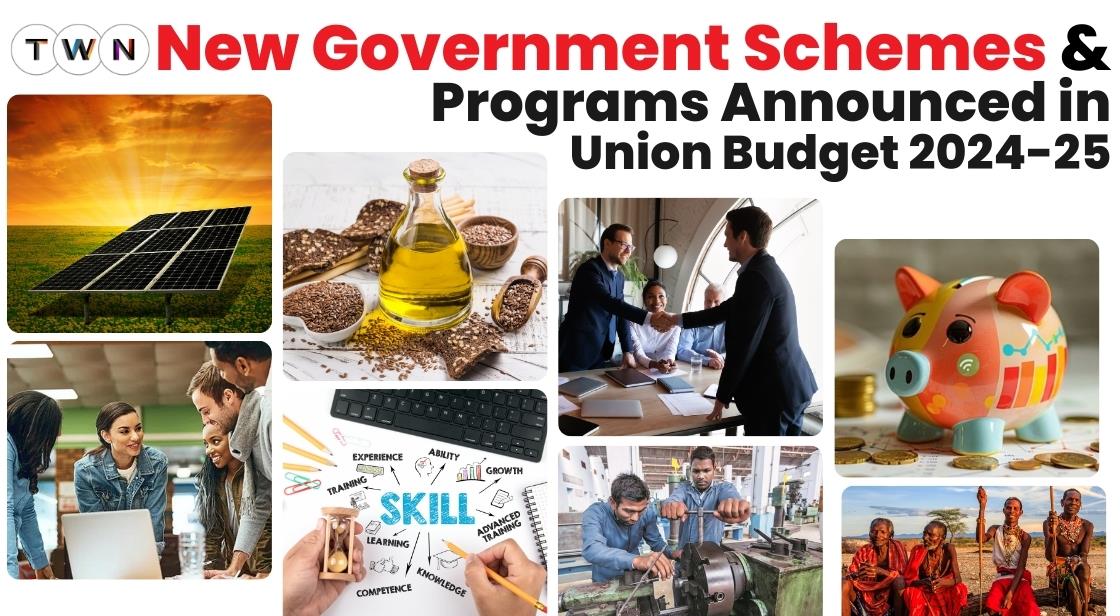New Government Schemes and Programs Announced in Union Budget 2024-25

Blog Post
Union Budget 2024-25 outlined a comprehensive vision for India's transformation into a 'Viksit Bharat' or Developed India by 2047. The budget prioritized nine key areas: agriculture, employment, skilling, human development, manufacturing, services, urban development, energy security, infrastructure, innovation, and next-generation reforms.
The budget was underpinned by a strong focus on inclusive growth, with significant allocations for sectors like agriculture, education, healthcare, and social welfare. It emphasized job creation, skill development, and infrastructure development as crucial drivers of economic growth. Additionally, the budget prioritized energy security through investments in renewable energy sources and nuclear power.
To achieve the ambitious goal of a developed India, the government introduced several flagship schemes, including the Purvodaya plan for the eastern region, the PM Surya Ghar initiative for rooftop solar, the Atmanirbhar Oil Seeds Abhiyan, employment-linked incentive schemes, a new skilling program, the Pradhan Mantri Janjatiya Unnat Gram Abhiyan, a credit guarantee scheme for MSMEs, and NPS Vatsalya.
These initiatives are designed to address specific challenges and create opportunities across various sectors of the economy.
Overall, Budget 2024-25 presented a roadmap for India's progress towards becoming a developed nation, with a strong emphasis on inclusive growth, job creation, and infrastructure development.
Explore the Full List of Schemes from the 2024-25 Union Budget
Viksit Bharat: The Blueprint for a Developed India
The Union Budget 2024-25 introduced the ambitious vision of 'Viksit Bharat' (Developed India) by 2047. This overarching goal encompasses a multi-faceted approach to propel India towards economic prosperity, social progress, and environmental sustainability.
Purvodaya: Developing India's Eastern Region
A cornerstone of the Viksit Bharat initiative is the 'Purvodaya' plan, designed to accelerate the development of India's eastern region. States like Jharkhand, Bihar, Odisha, West Bengal, and Andhra Pradesh will be at the heart of this development push.
-
Infrastructure Development: Significant investments in transportation, energy, and digital connectivity are planned to improve the region's infrastructure.
-
Human Capital Development: Focus on education, healthcare, and skill development will be crucial to enhancing the region's human capital.
-
Economic Growth: The government aims to create a conducive environment for businesses and industries to thrive, generating employment opportunities and boosting economic growth.
By transforming the eastern region into a growth engine, the government aims to reduce regional disparities and contribute significantly to India's overall development.
Nuclear Energy: A Pillar of Viksit Bharat
Recognizing the potential of nuclear energy in meeting India's growing energy demands and reducing carbon emissions, the government has outlined a strategic roadmap. Key initiatives include:
-
Partnership with the Private Sector: The government will collaborate with private players to establish Bharat Small Reactors, which are expected to be more efficient and cost-effective.
-
Research and Development: Investments in research and development will be made to advance nuclear technology and explore new possibilities, such as the Bharat Small Modular Reactor.
These efforts are aimed at enhancing India's energy security, reducing reliance on fossil fuels, and contributing to a cleaner environment.
Beyond Purvodaya and Nuclear Energy
While these two initiatives are prominent, the government's vision for Viksit Bharat encompasses a broader range of sectors and policies. Areas such as agriculture, manufacturing, digital economy, and social welfare are also expected to receive significant attention in the coming years.
The success of Viksit Bharat will depend on effective implementation, adequate resource allocation, and the active participation of both the government and the private sector.
Rooftop Solarisation Scheme
PM Surya Ghar: Muft Bijli Yojana - A Step Towards Energy Independence
The Indian government, under the aegis of its larger 'Viksit Bharat' vision, has introduced the 'PM Surya Ghar: Muft Bijli Yojana'. This ambitious initiative aims to install rooftop solar panels in one crore households, providing them with up to 300 units of free electricity per month.
Key Objectives of the PM Surya Ghar: Muft Bijli Yojana
-
Energy Independence: To reduce reliance on traditional power sources and promote clean, renewable energy.
-
Financial Savings: To provide substantial savings to households by offsetting electricity bills.
-
Job Creation: To stimulate employment opportunities in the solar energy sector, particularly in manufacturing, installation, and maintenance.
-
Electric Vehicle Promotion: To encourage electric vehicle adoption by providing charging infrastructure through rooftop solar systems.
Benefits for Households
Beyond the immediate benefit of free electricity, the scheme offers several long-term advantages:
-
Cost Savings: Households can expect to save approximately Rs. 15,000 to Rs. 18,000 annually on electricity bills.
-
Environmental Impact: By generating clean energy, households contribute to reducing carbon emissions and mitigating climate change.
-
Energy Security: Rooftop solar systems provide a reliable source of electricity, reducing dependence on the grid.
Economic Opportunities
The scheme is expected to create a significant number of jobs in the solar energy sector. Entrepreneurs can capitalize on the growing demand for solar panels and installation services. Additionally, the availability of surplus electricity generated by rooftop solar systems can be fed back into the grid, providing additional income opportunities.
Challenges and Way Forward
While the scheme holds immense promise, challenges such as initial investment costs, technical expertise, and grid integration need to be addressed. The government will need to provide adequate support and incentives to overcome these hurdles.
The PM Surya Ghar: Muft Bijli Yojana is a significant step towards India's goal of becoming a global leader in renewable energy. By empowering households to generate their own electricity, the scheme contributes to both environmental sustainability and economic growth.
Also Read: Key Sustainability and Energy Initiatives in Budget 2024
Atmanirbhar Oil Seeds Abhiyan
The Indian government has unveiled the 'Atmanirbhar Oil Seeds Abhiyan' as a strategic initiative to bolster domestic oilseed production and reduce the nation's dependence on imports. This ambitious program aims to achieve self-sufficiency in oilseeds such as mustard, groundnut, sesame, soybean, and sunflower.
Core Components of the Atmanirbhar Oil Seeds Abhiyan
-
Research and Development: The government will invest in research to develop high-yielding and resilient oilseed varieties suitable for diverse agro-climatic conditions across India.
-
Modern Farming Techniques: The adoption of advanced agricultural practices, including mechanization, precision farming, and improved soil health management, will be promoted to enhance oilseed productivity.
-
Market Linkage and Value Addition: The Abhiyan will focus on strengthening market linkages for oilseed farmers, ensuring remunerative prices and promoting value addition to increase farmers' income.
-
Procurement and Storage: The government will invest in expanding procurement infrastructure and storage facilities to handle increased oilseed production.
-
Crop Insurance: Comprehensive crop insurance coverage will be provided to protect farmers against losses due to adverse weather conditions and other risks.
The Road to Self-Sufficiency
By implementing these comprehensive measures, the government aims to significantly increase domestic oilseed production, reduce imports, and improve the livelihoods of farmers. The Atmanirbhar Oil Seeds Abhiyan is a crucial step towards India's goal of becoming a self-sufficient agricultural powerhouse.
Employment-Linked Incentive Schemes
The Indian government has announced a trio of employment-linked incentive schemes aimed at boosting job creation and supporting both new entrants and employers across various sectors. These initiatives are designed to stimulate economic growth and provide a much-needed impetus to the job market.
Scheme A: First-Timers Incentive
Targeted at young individuals entering the formal workforce, this scheme offers a direct cash incentive to new EPFO registrants. Eligible individuals who have recently joined the workforce and are earning up to Rs. 1 lakh per month will receive a one-time payment of up to Rs. 15,000 in three installments. The objective is to encourage youth participation in the formal economy and provide financial support during the initial stages of employment.
Scheme B: Manufacturing Sector Job Creation Incentive
To promote job growth in the manufacturing sector, the government has introduced an incentive scheme for both employers and employees. Businesses creating new jobs in manufacturing will be eligible for financial rewards linked to EPFO contributions for the first four years of employment. Similarly, newly hired employees in the manufacturing sector will receive direct incentives. This dual approach aims to stimulate job creation and retention in a key economic sector.
Scheme C: Employer Support Incentive
Recognizing the role of employers in job creation, the government has introduced a scheme to support businesses across all sectors. Employers who create new jobs with salaries up to Rs. 1 lakh per month will receive a reimbursement of a portion of their EPFO contributions for two years. This incentive is expected to encourage businesses to expand their workforce and contribute to overall employment growth.
Expected Impact and Challenges
These employment-linked incentive schemes are designed to address multiple facets of the employment landscape. By providing direct support to both employees and employers, the government aims to create a virtuous cycle of job creation and economic growth. However, successful implementation will require careful planning, monitoring, and evaluation to ensure that the incentives achieve their intended objectives.
Factors such as the potential for fraudulent claims, the sustainability of the schemes over the long term, and the overall impact on the job market will need to be closely monitored. Nevertheless, these initiatives represent a significant step towards addressing India's employment challenges and fostering a more inclusive and prosperous economy.
A New Skill India Initiative: Skilling 20 Lakh Youth
The Indian government has unveiled a comprehensive skilling program aimed at training 20 lakh young individuals over the next five years. This initiative seeks to bridge the gap between education and employment by aligning skill development programs with the evolving needs of the industry.
Key Components of the New Skill India Mission
-
Industry Collaboration: The program emphasizes a strong partnership between the government, industry, and state governments. This collaborative approach ensures that training programs are aligned with the actual skill requirements of the job market.
-
Upgradation of Industrial Training Institutes (ITIs): To enhance the quality of training, 1,000 ITIs will be modernized and upgraded. These institutes will serve as hubs for skill development, offering a range of courses tailored to industry needs.
-
Curriculum Relevance: The curriculum for the training programs will be designed in close consultation with industry experts to ensure that trainees acquire the necessary skills for employment. New courses addressing emerging skill requirements will be introduced to keep pace with technological advancements.
-
Outcome-Oriented Approach: The program will focus on achieving tangible results, with emphasis on placement rates and employment outcomes of the trained youth.
Expected Impact
By skilling 20 lakh young people, the government aims to create a skilled workforce that can contribute to India's economic growth. The program is expected to enhance employability, reduce unemployment rates, and boost the country's competitiveness in the global market.
Additionally, the upgradation of ITIs will strengthen the vocational training ecosystem and provide a platform for lifelong learning and skill enhancement.
This initiative is a significant step towards realizing the vision of a 'Skill India' and empowering the youth with the necessary capabilities to succeed in the modern economy.
Also Read: How Electronic Waste Affects Your Health and Planet?
Pradhan Mantri Janjatiya Unnat Gram Abhiyan
The Indian government has launched a comprehensive initiative, the Pradhan Mantri Janjatiya Unnat Gram Abhiyan (PMJUGA), with the aim of uplifting the socio-economic conditions of tribal communities across the nation. This ambitious program seeks to address the multifaceted challenges faced by tribal populations through a saturation approach, focusing on tribal-majority villages and aspirational districts.
Core Objectives of PMJUGA
The primary goal of PMJUGA is to enhance the overall quality of life for tribal people by:
-
Providing universal coverage: Ensuring that all tribal families in targeted villages benefit from the scheme.
-
Addressing holistic development: Focusing on a wide range of development areas, including education, healthcare, infrastructure, livelihood, and skill development.
-
Reducing disparities: Bridging the gap between tribal and non-tribal communities in terms of access to basic amenities and opportunities.
-
Empowering tribal communities: Building the capacity of tribal people to participate in and benefit from development processes.
Key Features of the PMJUGA Scheme
-
Saturation Coverage: The scheme will be implemented in 63,000 tribal-majority villages and aspirational districts, reaching out to approximately 5 crore tribal people.
-
Multi-sectoral Approach: PMJUGA will encompass various government departments and ministries to ensure a holistic and integrated approach to development.
-
Community Participation: The program will emphasize the involvement of tribal communities in planning and implementation to ensure that their needs and aspirations are met.
-
Monitoring and Evaluation: A robust monitoring and evaluation system will be in place to track progress, measure outcomes, and make necessary adjustments.
By addressing the specific needs and challenges of tribal communities, PMJUGA aims to create sustainable livelihoods, improve access to essential services, and empower tribal people to become active participants in India's development journey.
Credit Guarantee Scheme for MSMEs: A Boost to Manufacturing
The Indian government has introduced a novel credit guarantee scheme aimed at stimulating investment and growth within the MSME manufacturing sector. This initiative seeks to address the persistent challenge of collateral-based lending, which has often hindered the growth of small businesses.
Key Features of the Credit Guarantee Scheme
-
Collateral-Free Lending: The scheme will facilitate term loans for MSMEs to acquire machinery and equipment without demanding collateral or third-party guarantees. This is a significant departure from traditional lending practices and aims to improve access to finance for MSMEs.
-
Credit Risk Pooling: The scheme will operate on a credit risk pooling model, mitigating the risk for lenders by distributing it across a pool of MSMEs.
-
Guarantee Coverage: A dedicated guarantee fund will provide coverage of up to Rs. 100 crore to each applicant, offering financial protection to lenders.
-
Fee Structure: Borrowers will be required to pay an upfront guarantee fee and an annual service fee on the reduced loan balance.
Expected Impact
By removing the hurdle of collateral requirements, this credit guarantee scheme is expected to:
-
Enhance access to finance: Enable a larger number of MSMEs to acquire the necessary machinery and equipment for expansion.
-
Boost manufacturing output: Stimulate investment in the manufacturing sector, leading to increased production and job creation.
-
Promote entrepreneurship: Encourage new entrepreneurs to enter the manufacturing sector by reducing financial barriers.
-
Strengthen the MSME ecosystem: Contribute to the overall growth and development of the MSME sector.
This initiative aligns with the government's broader efforts to support MSMEs and promote economic growth. By providing easier access to credit, the scheme is expected to play a crucial role in the development of the manufacturing sector in India.
Credit Support to MSMEs during Stress Period
Credit Lifeline for Stressed MSMEs
The Indian government has introduced a novel credit support mechanism to provide a lifeline to MSMEs facing financial stress. Recognizing the challenges faced by small businesses in maintaining credit flow during difficult times, the government has unveiled a credit guarantee scheme.
Key Features of the Scheme
-
Bridging the Credit Gap: The scheme aims to address the critical issue of MSMEs facing difficulties in accessing credit during periods of financial stress.
-
Focus on Special Mention Accounts (SMAs): MSMEs categorized as SMAs, indicating early signs of stress, will be the primary beneficiaries of this scheme.
-
Government-Backed Guarantee: A government-promoted fund will provide guarantees to lenders, mitigating the risk associated with lending to stressed MSMEs.
-
Continued Credit Access: By ensuring continued credit availability, the scheme seeks to prevent MSMEs from slipping into the Non-Performing Asset (NPA) category.
Expected Impact
This credit guarantee scheme is expected to have a positive impact on the MSME sector by:
-
Improving access to finance: Providing a much-needed financial lifeline to MSMEs facing temporary difficulties.
-
Reducing the risk of NPAs: Mitigating the risk of loan defaults for banks and financial institutions.
-
Supporting business continuity: Enabling MSMEs to overcome financial challenges and sustain their operations.
-
Boosting economic growth: By supporting the MSME sector, the scheme contributes to overall economic development and job creation.
The government's initiative to address the specific needs of stressed MSMEs is a significant step towards creating a more resilient and sustainable business environment in India.
Comprehensive scheme for Internship Opportunities
A Mega Internship Drive: Skill India Mission
The government has announced an ambitious internship program aimed at providing practical work experience to one crore young individuals over a five-year period. This initiative seeks to bridge the gap between academia and the professional world, enhancing employability and fostering entrepreneurial skills among the youth.
Key Features of the Internship Scheme
-
Large-Scale Internship Opportunities: The program will offer internships in 500 top companies across various sectors, providing exposure to diverse work environments.
-
Stipend Support: Interns will receive a monthly stipend of Rs. 5,000 along with a one-time assistance of Rs. 6,000 to support their living expenses during the internship period.
-
Industry Collaboration: Companies participating in the scheme are required to bear the training costs and contribute 10% of the internship cost from their Corporate Social Responsibility (CSR) funds.
-
Duration and Focus: Internships will be of 12 months duration, offering comprehensive exposure to different roles and functions within the organization.
Expected Outcomes
This internship program is expected to:
-
Enhance employability: Equip young individuals with practical skills and industry exposure, making them more employable.
-
Foster entrepreneurship: Cultivate a culture of innovation and entrepreneurship among interns.
-
Strengthen industry-academia linkages: Facilitate knowledge sharing and collaboration between educational institutions and companies.
-
Address skill gaps: Identify skill shortages and align training programs accordingly.
By providing a platform for young talent to gain real-world experience, the government aims to create a skilled and employable workforce that can contribute to India's economic growth and development.
NPS Vatsalya
NPS Vatsalya: A Head Start for Your Child's Financial Future
The Indian government has introduced the NPS Vatsalya scheme as part of its financial inclusion initiatives. This scheme offers parents and guardians a platform to invest in their children's future by opening a National Pension System (NPS) account on their behalf.
Key Features of NPS Vatsalya
-
Early Start: Parents or guardians can open an NPS Vatsalya account for their child as early as at birth, allowing for the power of compounding to work its magic over a longer period.
-
Seamless Transition: Upon the child attaining the age of majority, the NPS Vatsalya account can be effortlessly converted into a regular NPS account, ensuring continuity of investment and benefits.
-
Long-Term Financial Security: NPS Vatsalya promotes the habit of saving and investing for the future, providing a strong financial foundation for the child.
-
Government Backing: As a government-sponsored scheme, NPS Vatsalya offers the security and stability associated with government-backed investments.
Benefits of NPS Vatsalya
-
Early Start Advantage: Starting investments early in a child's life allows for significant wealth accumulation due to the power of compounding.
-
Tax Benefits: Contributions to NPS Vatsalya may qualify for tax deductions under Section 80C of the Income Tax Act.
-
Market-Linked Returns: Investments in NPS are market-linked, offering the potential for higher returns compared to traditional savings instruments.
-
Pension Benefits: Upon retirement, the accumulated corpus can be converted into a regular pension, providing a steady income stream.
By encouraging parents to plan for their children's financial future, NPS Vatsalya aims to create a generation of financially secure and independent individuals.
Conclusion
The Union Budget 2024-25 marks a pivotal moment in India’s journey towards becoming a 'Viksit Bharat' (Developed India) by 2047. With a broad array of initiatives spanning agriculture, energy, employment, and social welfare, the budget reflects a comprehensive strategy for inclusive growth and development.
Key schemes such as the Purvodaya plan, PM Surya Ghar, and Atmanirbhar Oil Seeds Abhiyan are set to drive significant progress in regional development, energy independence, and agricultural self-sufficiency. The introduction of employment-linked incentive schemes, a new skilling program, and credit support measures for MSMEs aims to enhance job creation, support small businesses, and empower the youth. Additionally, the Pradhan Mantri Janjatiya Unnat Gram Abhiyan and NPS Vatsalya reflect the government’s commitment to improving the lives of tribal communities and fostering long-term financial security for children.
These initiatives are not just policy changes but represent a strategic framework designed to address critical challenges and leverage opportunities for sustainable growth. As the government embarks on implementing these programs, the focus will be on ensuring effective execution, resource allocation, and collaboration with stakeholders to realize the vision of a developed and prosperous India.
By laying out this ambitious roadmap, the Union Budget 2024-25 is poised to shape India’s economic landscape, enhance quality of life, and build a resilient and inclusive future for all its citizens.
You May Like
EDITOR’S CHOICE












